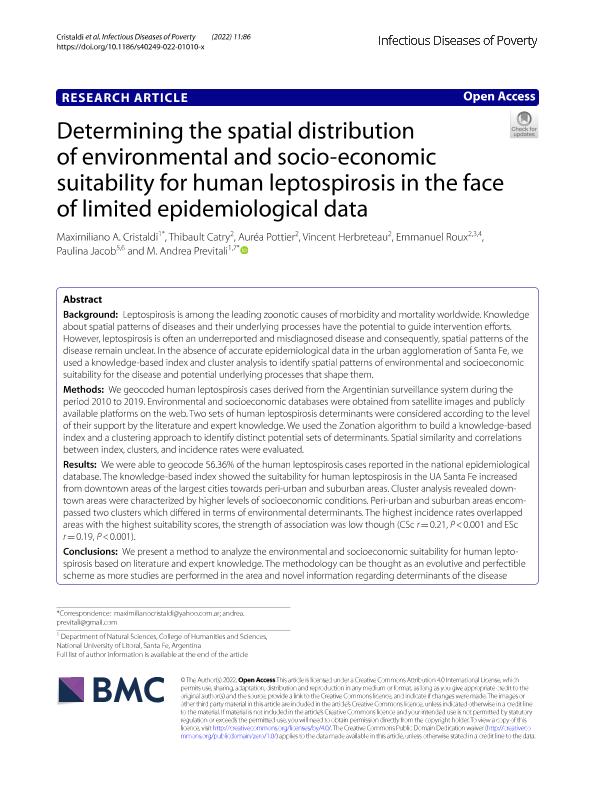Mostrar el registro sencillo del ítem
dc.contributor.author
Cristaldi, Maximiliano Ariel

dc.contributor.author
Thibault, Catry
dc.contributor.author
Pottier, Auréa
dc.contributor.author
Herbreteau, Vincent

dc.contributor.author
Roux, Emmanuel
dc.contributor.author
Jacob, Paulina

dc.contributor.author
Previtali, Maria Andrea

dc.date.available
2023-09-29T11:01:17Z
dc.date.issued
2022-08
dc.identifier.citation
Cristaldi, Maximiliano Ariel; Thibault, Catry; Pottier, Auréa; Herbreteau, Vincent; Roux, Emmanuel; et al.; Determining the spatial distribution of environmental and socio-economic suitability for human leptospirosis in the face of limited epidemiological data; BioMed Central; Infectious Diseases of Poverty; 11; 1; 8-2022; 1-19
dc.identifier.issn
2049-9957
dc.identifier.uri
http://hdl.handle.net/11336/213531
dc.description.abstract
Background: Leptospirosis is among the leading zoonotic causes of morbidity and mortality worldwide. Knowledge about spatial patterns of diseases and their underlying processes have the potential to guide intervention efforts. However, leptospirosis is often an underreported and misdiagnosed disease and consequently, spatial patterns of the disease remain unclear. In the absence of accurate epidemiological data in the urban agglomeration of Santa Fe, we used a knowledge-based index and cluster analysis to identify spatial patterns of environmental and socioeconomic suitability for the disease and potential underlying processes that shape them. Methods: We geocoded human leptospirosis cases derived from the Argentinian surveillance system during the period 2010 to 2019. Environmental and socioeconomic databases were obtained from satellite images and publicly available platforms on the web. Two sets of human leptospirosis determinants were considered according to the level of their support by the literature and expert knowledge. We used the Zonation algorithm to build a knowledge-based index and a clustering approach to identify distinct potential sets of determinants. Spatial similarity and correlations between index, clusters, and incidence rates were evaluated. Results: We were able to geocode 56.36% of the human leptospirosis cases reported in the national epidemiological database. The knowledge-based index showed the suitability for human leptospirosis in the UA Santa Fe increased from downtown areas of the largest cities towards peri-urban and suburban areas. Cluster analysis revealed downtown areas were characterized by higher levels of socioeconomic conditions. Peri-urban and suburban areas encompassed two clusters which differed in terms of environmental determinants. The highest incidence rates overlapped areas with the highest suitability scores, the strength of association was low though (CSc r = 0.21, P < 0.001 and ESc r = 0.19, P < 0.001). Conclusions: We present a method to analyze the environmental and socioeconomic suitability for human leptospirosis based on literature and expert knowledge. The methodology can be thought as an evolutive and perfectible scheme as more studies are performed in the area and novel information regarding determinants of the disease become available. Our approach can be a valuable tool for decision-makers since it can serve as a baseline to plan intervention measures.
dc.format
application/pdf
dc.language.iso
eng
dc.publisher
BioMed Central

dc.rights
info:eu-repo/semantics/openAccess
dc.rights.uri
https://creativecommons.org/licenses/by/2.5/ar/
dc.subject
CLUSTER ANALYSIS
dc.subject
ENVIRONMENTAL CONDITIONS
dc.subject
KNOWLEDGE-BASED INDEX
dc.subject
SOCIOECONOMIC GROUPS
dc.subject
SPATIAL EPIDEMIOLOGY
dc.subject
UNDERREPORTED MISDIAGNOSED DISEASES
dc.subject.classification
Enfermedades Infecciosas

dc.subject.classification
Ciencias de la Salud

dc.subject.classification
CIENCIAS MÉDICAS Y DE LA SALUD

dc.title
Determining the spatial distribution of environmental and socio-economic suitability for human leptospirosis in the face of limited epidemiological data
dc.type
info:eu-repo/semantics/article
dc.type
info:ar-repo/semantics/artículo
dc.type
info:eu-repo/semantics/publishedVersion
dc.date.updated
2023-07-07T22:14:04Z
dc.identifier.eissn
2049-9957
dc.journal.volume
11
dc.journal.number
1
dc.journal.pagination
1-19
dc.journal.pais
Reino Unido

dc.description.fil
Fil: Cristaldi, Maximiliano Ariel. Consejo Nacional de Investigaciones Científicas y Técnicas. Oficina de Coordinación Administrativa Ciudad Universitaria. Instituto de Ecología, Genética y Evolución de Buenos Aires. Universidad de Buenos Aires. Facultad de Ciencias Exactas y Naturales. Instituto de Ecología, Genética y Evolución de Buenos Aires; Argentina
dc.description.fil
Fil: Thibault, Catry. Université Montpellier II; Francia
dc.description.fil
Fil: Pottier, Auréa. Centre National de la Recherche Scientifique. Institut de Recherche pour le Développement; Francia
dc.description.fil
Fil: Herbreteau, Vincent. Centre National de la Recherche Scientifique. Institut de Recherche pour le Développement; Francia
dc.description.fil
Fil: Roux, Emmanuel. Centre National de la Recherche Scientifique. Institut de Recherche pour le Développement; Francia
dc.description.fil
Fil: Jacob, Paulina. Dirección Nacional de Instituto de Investigación. Administración Nacional de Laboratorios e Instituto de Salud "Dr. C. G. Malbran". Instituto Nacional de Enfermedades Respiratorias; Argentina
dc.description.fil
Fil: Previtali, Maria Andrea. Universidad Nacional del Litoral; Argentina. Consejo Nacional de Investigaciones Científicas y Técnicas. Centro Científico Tecnológico Conicet - Santa Fe; Argentina
dc.journal.title
Infectious Diseases of Poverty
dc.relation.alternativeid
info:eu-repo/semantics/altIdentifier/doi/http://dx.doi.org/10.1186/s40249-022-01010-x
Archivos asociados
